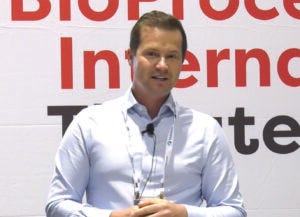- Sponsored Content
- Gene Therapies
The Future of AAV Gene Therapy Is ScalableThe Future of AAV Gene Therapy Is Scalable
August 24, 2022
Sponsored by WuXi Advanced Therapies
 Ryan Cawood, chief scientific officer, WuXi Advanced Therapies.
Ryan Cawood, chief scientific officer, WuXi Advanced Therapies.
Cawood began by noting that WuXi Advanced Therapies supports clients throughout their journeys toward
developing cell and gene therapies. With the acquisition of the UK-based contract research organization (CRO) Oxgene and its adenoassociated virus (AAV) and lentivirus platforms (known as the TESSA and LentiVEX platforms/technologies, respectively), WuXi Advanced Therapies now can scale processes up to good manufacturing practice (GMP) manufacturing through to commercial supply.
After describing the work that takes place in different company locations, Cawood focused on the TESSA technology, which provides a plasmid-free alternative for large-scale clinical manufacturing. Most AAV manufacturing is based on plasmid transfection. Not only are such processes expensive, but transfection can occur only at a certain cell density. Adenovirus can be used to manufacture AAV, and such processes are easy to scale up. However, they yield as much adenovirus as AAV, creating major downstream purification issues and raising product-contamination concerns. The goal of the TESSA technology is to use an adenoviral vector to manufacture AAV without contaminating the preparation. In the early phase of the adenoviral life cycle, genes in the AAV helper plasmid are expressed by cells to manufacture both AAV and adenovirus. But in late phases of the cycle, those genes induce cells to make unwanted adenovirus. The TESSA technology is designed to close down all of those late genes.
Cawood described how TESSA technology regulates the promoter that drives expression of structural proteins. The adenovirus titer is determined by the promoter that it represses, so the more the virus tries to make itself, the more it cripples itself. WuXi Advanced Therapies is working on different models of the technology and now has made TESSA rep-cap genes for all of the main serotypes that people work with. Production titers for one particular construct yielded 1 × 1012 gc/mL. TESSA rep-cap 1, 2, 4, and 5 showed significant improvements in productivity per cell in a suspension-based process for all the serotypes that the company has worked on — generally 10-fold more than what is produced using a plasmid system. He also described how data from a cell line developed at WuXi Advanced Therapies showed improvement in packaging efficiencies.
Cawood noted that the US Food and Drug Administration (FDA) is increasing pressure on manufacturers to ensure absence of residual contaminants and confirm efficacy. WuXi Advanced Therapies has tested a number of different serotypes and compared the ability of those AAV particles to infect cells with AAVs made from the plasmid process. He illustrated work showing that in some cases, the particles were >10-fold more infectious when produced by TESSA technology than when induced by the plasmid-based process. In an example of scaling up the TESSA technology for AAV6 to 50 L, every cell in the population contained the adenoviral DNA after three days. Around 3% of the particles were able to infect a cell compared with 0.5%–0.7% with the plasmid system. Before any purification, 66% of full particles were obtained in the bioreactor. Following purification, the number came to about 102%, and using analytical ultracentrifugation yielded 94.4% full capsids of pure AAV. In an example of scaling up the technology for AAV2, the yields were lower than in the bioreactor but still 20× higher than what was produced by the plasmid-based equivalent. In an alternative model, the company introduced the AAV genome into the chromosome of an HEK293 cell line. The cells were infected with just one TESSA vector, after which AAV was removed with purification.
Other examples illustrated how the technology increased AAV particle yields for all serotypes tested. It increased particle infectivity for a number of the serotypes, is safe and efficient, and removes dependency on transfection. It allows for a number of different operations in bioreactors that simply can’t be done in a transfection-based process.
Cawood concluded by noting that the company provides materials that clients can access through evaluation in their own laboratories. WuXi Advanced Therapies also can construct specific TESSA vectors for clients.
Fill out the form below to view the full BPI Theater presentation.
You May Also Like






